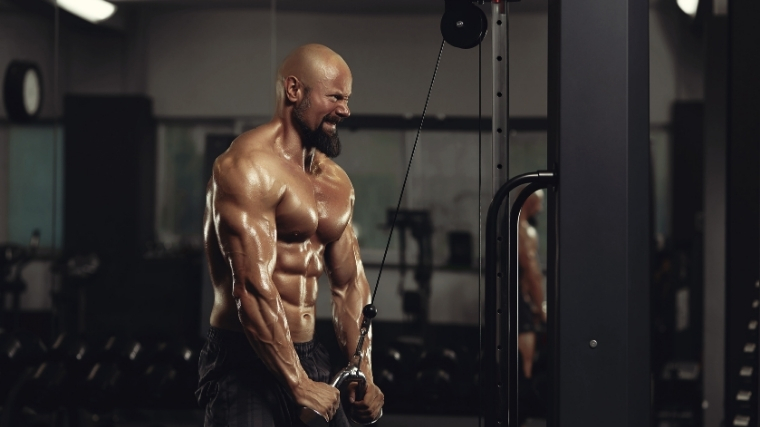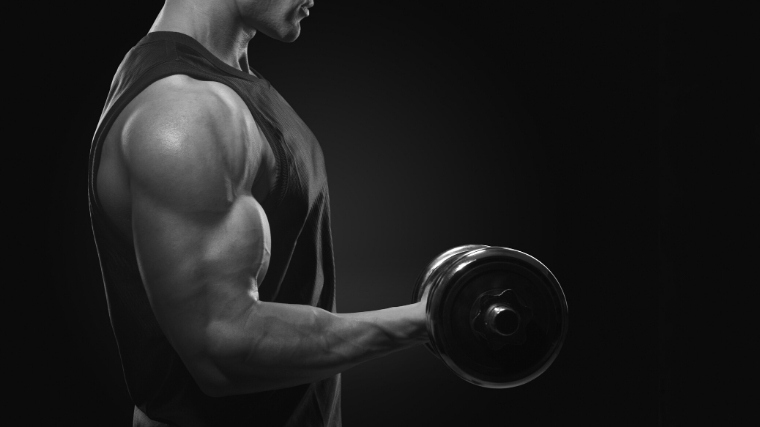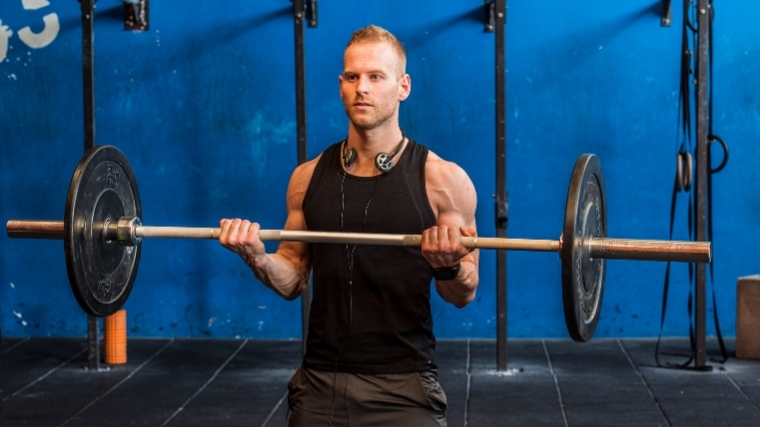It’s ok to want big arms. Lifting weights can boost your confidence, improve your health, and make you stronger — but wanting to look buff in a sweater is a perfectly acceptable goal, too. Aesthetics aside, bigger stronger arms can help you lift more weight — after all, they’re key players in pulling and pushing moves — and are less prone to serious injury.
Below, we’ve compiled the 10 best arm exercises you can do to build more muscle. You’ll also learn more about how to specifically program arm workouts into your other training days and how to progress with them.
The Best Arm Exercises
- EZ-Bar Curl
- Concentration Curl
- Hammer Curl
- Biceps Cable Curl
- Chin-up
- Dumbbell Skull Crusher
- Dip
- JM Press
- Triceps Pushdown
- Triceps Kickback
EZ-Bar Curl
The main benefit of the barbell curl is that it allows you, relatively speaking, to lift more weight as you’re both standing and curling with two hands. And by using an ez-bar — a relatively affordable and accessible piece of home gym equipment — your hands turn inward slightly, alleviating potential wrist pain allowing you to lift more than what would be possible with a standard straight bar.

Benefits of the EZ-Bar Curl
- You can lift more weight relative to other weighted biceps exercises.
- The angled grip will feel better on your wrists compared to a straight bar.
- That same angle grip puts you in a better position to lift heavier than a standard barbell curl.
How to Do the EZ-Bar Curl
Load an ez-bar up with a weight that you can curl comfortably with good form (meaning you’re not using momentum to cheat the weight up). Grip the middle of the bar so that your hands are angled in. Keep your arms at your sides and flex your elbows to curl the weight up towards your shoulders. Lower the weight back down so that your arms are fully extended with control.
Concentration Curl
The concentration curl was made famous by Arnold Schwarzenegger in the 1975 film “Pumping Iron.” The Austrian Oak was bent over, one hand resting on a knee and his other arm curl weight straight up. Arnold was truly ahead of his time. ACE Fitness measured eight popular biceps exercises’ muscle recruitment and found that concentration curls were far and away from the best. Another bonus is that these are done one-arm at a time, and so you’ll be doing more work and therefore burning more calories, which never really hurt anyone.
Benefits of the Concentration Curl
- The concentration elicits the most muscle recruitment of any curl.
- Curling one arm at a time will burn more calories.
How to Do the Concentration Curl
Grab a light dumbbell and hold it in one hand. Hinge at the hips and place your free hand on your knee (you can also brace on a bench or a dumbbell rack). Let the loaded arm extend straight down. Keeping your arm in a straight line, flex your elbow to curl the weight up towards your opposite shoulder. You should feel a strong, almost painful contraction in your bicep.
Hammer Curl
This variation has you curl two dumbbells with your palms facing. Similar to the ez-bar curl, this neutral wrist position is generally more comfortable. This curl variation is known to target the biceps brachialis which sits underneath the biceps and makes your arms look thicker.
[Related: 3 Reasons Why Bicep Curls Are Good for Your Shoulders]
Benefits of the Hammer Curl
- The palms-facing position is far more comfortable on your wrists.
- The hammer curl targets the oft-forgotten biceps brachialis, which makes your arm appear thicker.
How to Do the Hammer Curl
Hold a dumbbell in each hand, and make sure that your palms are facing one another. Keep your chest up, and curl the weights up towards your shoulders. You can let your elbows travel forward slightly. When the dumbbells are near your shoulders, feel for a contraction, and, once you find it, hold that position for a second or two. Lower the weights back down under control.
Biceps Cable Curl
When you curl a dumbbell or barbell, it becomes easier at the top and bottom of the exercise, since the weight is closer to your body. A cable is heavy throughout the entire range of motion of a curl. Also, instead of using just a straight bar, you can curl with an ez-bar attachment, a rope, even a pair of handles if you like. And if you want to perform a dropset — where you curl heavy weight, drop the weight, curl again, and repeat — you can easily adjust the weight stack.
Benefits of the Cable Curl
- There’s constant tension on the muscle for the full range of motion.
- The lifter can use any attachment for a different feel or angle.
- The weight can be quickly adjusted for dropsets.
How to Do the Cable Curl
Set a cable pulley to the lowest point of the machine and attach your bar of choice — a straight bar, ez-bar, and rope are all standard options. Select a moderate weight, and grab the handle in both hands. Take a few steps back so that the weight stack is suspended and the cable is taut. Slowly curl the bar up towards your shoulders and lower the bar back down with control.
Chin-up
The chin-up is a bodyweight move known for its back-building benefits, but the biceps are a crucial player in this exercise, too. While the chin-up doesn’t isolate your biceps, it does create a lot of tension. That’s because you’re pulling your entire body weight up. Think about that: Say you weigh 200 pounds, and you can curl 100 pounds on a barbell — the chin-up is having you pull 100% more. (We know that a chin-up and barbell curl are different bicep exercises, so the weight increase isn’t entirely comparable, but it’s still an uptick.)
Benefits of the Chin-up
- The move also targets the muscles in your back.
- The biceps will be helping to lift more weight than most people can curl.
How to Do the Chin-up
Grab onto a pull-up bar with an underhand grip, and let your body hang with your arms fully extended. Squeeze your shoulder blades together and pull your body up, leading with your elbows. Keep pulling until your chin is at or above the bar, lower yourself back down under control.
Dumbbell Skull Crusher
Despite its sinister name, this may be one of the most tricep-friendly moves you can do. You’re probably aware of this already since the skull crusher has been an arm-day staple for, well, we don’t have an exact date, but it’s been around for a while. The dumbbell version allows you to isolate each arm, which lets your weaker side platy catch up. You can also perform these with your palms up or facing each other, which is usually more comfortable for your wrists. The skull crusher isn’t a new triceps exercise, but it’s an effective one.
Benefits of the Dumbbell Skull Crusher
- Dumbbell skullcrushers can be done unilaterally to allow your weaker side to catch up.
- These can be performed with a neutral grip for wrist comfort.
How to Do the Dumbbell Skull Crusher
Pick up two light to moderate dumbbells and lay down, back first, on a bench with your feet firmly planted on the floor. Raise both dumbbells over your chest, arms fully extended and palms facing each other. Flex at the elbows to lower the dumbbells toward your forward and to the top of your shoulders. It’s ok to let your upper arms travel backward a little bit as this can also increase the stretch you feel on your triceps.
Dip
The dip is lauded for its ability to add muscle in one’s chest, triceps, and shoulder. Your core gets a workout, too, as the body stabilizes itself while suspended between two parallel bars; If you angle your body forward, you’ll better target the muscles in your chest; keep your torso upright, however, and the load shifts to your triceps a bit more. Similar to the chin-up, you’re forcing your triceps to support your entire body weight, which is most likely more than what you can lift on a cable machine or a straight bar.
Benefits of the Dip
- The muscle is overloaded with your full body weight, and not just what you can lift on a bar.
- Your core gets a workout, too, as you stabilize your suspended body.
How to Do the Dip
Suspend yourself between two parallel bars, with your elbows locked out. Get stable and then bend your elbows to lower your body down until your arms are bent at 90 degrees. Keep your chest up and your body straight to work your triceps more than your chest. Press back up.
J.M. Press
This exercise, which is the brainchild of powerlifter J.M. Blakley who has benched 710-pound equipped, is essentially a bench press, except you lower the bar to your neck and keep your elbows tucked in to keep the tension on the triceps. This bench press-skull crusher hybrid allows you to place a heavier load on your triceps, for a more significant stimulus and has more carryover to your bench press.
[Related: 5 Unconventional Tips for a Bigger Bench Press]
Benefits of the J.M. Press
- This move allows you to overload your triceps with more weight than you could handle with a normal skull crusher.
- This move more closely mimics the bench press for direct carryover to the movement for powerlifters or strength enthusiasts.
How to Do the J.M. Press
Set up on a bench press and hold the bar with a closer grip, hands shoulder-width apart. Keep your elbows tucked in at bout 45 degrees and lower the bar towards your chest. When you start to feel your chest working, about halfway, shift the bar back towards your forehead so that it’s eventually sitting over your neck. You should feel a stretch in your triceps. Reverse the motion.
Triceps Pushdown
You probably don’t need to be introduced to the triceps pushdown — it’s a classic. By pushing an attachment down with just your triceps, you can fully isolate the area. The cable also keeps constant tension on the muscle, and you can attach a variety of handles for a varied grip to better feel the contraction or alleviate elbow or wrist pain.

Benefits of the Triceps Pushdown
- The cable machine keeps constant tension on the muscle.
- You can fully isolate your triceps as no other muscles work to move the weight.
- Varied grips allow for more comfort and different angles.
How to Do the Triceps Pushdown
Set a cable pulley to the highest setting and attach your handle of choice — a straight bar, ez-bar, rope, or D-handle. Grab it with both hands and stand about a foot or so away from the cable machine. Keep your elbows tucked in at your sides and start with the bar at about chest height. Flex your elbows to push the bar down until your arms are fully extended. The handle should be at your hips. Slowly lower the weight back to the starting position.
Triceps Kickback
Ok, this isn’t the most badass looking move in the gym, but you can isolate your triceps with it. Also, because you need to hinge at your hips and drive a dumbbell straight back behind you, only light weight is required. And whenever you can load your muscles with less weight, you’re sparing yourself from potential injury.
Benefits of the Triceps Kickback
- Less weight is required to isolate the triceps, due to body positioning, and so it’s an inherently safer exercise.
- Because you only need light weight, this move is pretty accessible and can be done even with water bottles or a loaded backpack.
How to Do the Triceps Kickback
Grab a light dumbbell in each hand and hinge forward at the hips until your torso is just about parallel to the floor. Bend your arms at 90 degrees and tuck your elbows into your sides. Flex your elbows and extend your arms back behind you until they’re straight. Hold the contraction for a beat, and then bring the weights back down to your sides.
How Often Should You Train Arms?
The first thing you need to figure out is your total volume per week. For hypertrophy (muscle growth), more is better (within reason). One study had lifters perform both the bench press and squat three times per week. One group performed one set per workout, another did three sets, and the third group was assigned five sets per workout. When it came to gaining muscle, the high-volume group saw the best results. (1)
Your arms are much smaller than the chest and legs, so you may not need as much volume. When it comes to arm training frequency, we suggest somewhere between eight to 12 sets weekly for new lifters (a year or less of weight lifting experience) and 10 to 14 sets per week for more seasoned gym-goers. Keep in mind these set recommendations are per muscle group.

How you split up your arm training is important, too. You can bust out eight sets for your triceps and biceps each in one workout, but then you’ll risk DOMS. And since your bi’s and tri’s are involved in a lot of upper-body movements, muscle soreness may impede your other workouts. Instead, you can break up your arm training into two to three workouts per week, paired with either a similar or unrelated muscle group.
Your biceps are involved in all pulling exercises, and your triceps are responsible for pushing. Some lifters prefer to pair the biceps and triceps with muscles that don’t recruit them — like chest and biceps or back and triceps — since your arms will be fresher. Others reason you’re already fatiguing that area and that the muscles work synergistically, so it’s more optimal to work them together. If you follow an upper and lower body split, then tack a few sets of each muscle onto the end of your upper body workouts. You can decide what works best for you.
How to Progress Your Arm Training
Building more muscular arms comes down to progressive overload, which means you’ll add just a bit more stress to your muscle each workout. This can be achieved by lifting more weight, performing more reps, or even changing the tempo. For the sake of ease, we suggest trying progressive overload with reps.
Pick a number of reps to perform for each set, and then add one rep to each set each week. For example, you can do three sets of 10 reps for hammer curls. After four weeks, you will be performing three sets of 13 reps. After four weeks, drop the reps back down to your starting rep number and up the weight by two and a half to five pounds. Repeat the process.

Train in both a lower and higher rep range. While doing fewer, heavier reps won’t make you bigger, they will make you stronger. (2) And that strength will allow you to, over time, lift more weights, which is what you need to do to continue to overload your target area progressively. In this instance, strength isn’t the end goal — it’s a means to an end. A stronger muscle is a bigger muscle.
A good general rule of thumb is to lift heavier at the start of your workout and then move on to lighter, higher-rep sets. Otherwise, you’ll be too fatigued to lift more weight. Start off your arms workouts by performing an exercise for five to eight reps, with a weight you can do for one rep short of failure. Then, perform your other exercises for eight to 12 reps.
More Arm Training Tips
Advance your arm training knowledge even further with this selection of articles on all things biceps and triceps.
- Chase the Pump, a Powerlifter’s Guide to Arm Training
- Arms Growing Stubbornly Slow? Try Using Biceps and Triceps Eccentric Training
References
- Schoenfeld BJ, Contreras B, Krieger J, et al. Resistance Training Volume Enhances Muscle Hypertrophy but Not Strength in Trained Men. Med Sci Sports Exerc. 2019;51(1):94-103. doi:10.1249/MSS.0000000000001764
- Schoenfeld BJ, Grgic J, Ogborn D, Krieger JW. Strength and Hypertrophy Adaptations Between Low- vs. High-Load Resistance Training: A Systematic Review and Meta-analysis. J Strength Cond Res. 2017 Dec;31(12):3508-3523. doi: 10.1519/JSC.0000000000002200. PMID: 28834797.
Feature image courtesy of Improvisor/Shutterstock